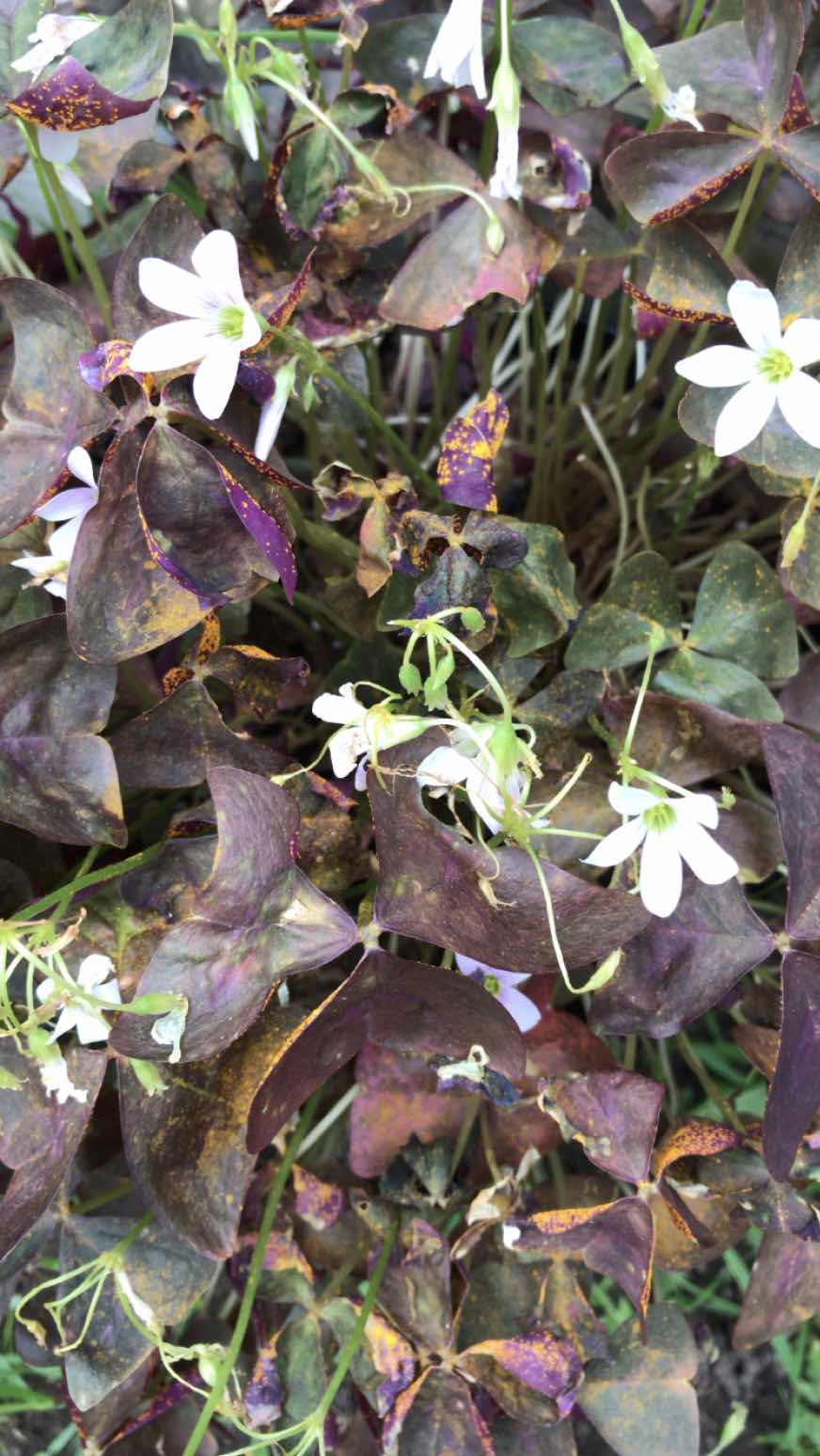As promised, here is the annual oxalis triangularis update — it’s a highly requested post as the popularity of these pretty purple dancing leaves are still on the rise in the plant world. I think this has to do with the fact that the last two or three years has seen this plant be marketed as a houseplant, particularly within the online plant community. But before we get started, it’s worth saying that many gardeners (in the UK) see this plant as a weed that appears in clumps nestled in borders or sparse flurries of purple at at the base of outdoor planters.
In this post, I’m going to show you the process of re-planting my tubers this Spring after moving + show you some progress up to this point. I will also address something I just discovered on one of my plants over the weekend + how I plan to deal with it.
If you want to read more about oxalis care in general, or to see how my plant has matured over the last few years I will link my posts here (they are clickable links!) :
- Oxalis triangularis: dormancy care
- Oxalis triangularis tubers update
- Oxalis triangularis gets ready for Spring



My tubers this spring
When I moved, I threw all my tubers + soil they’d been sitting in into a tub so that they were easier to transport. I would have done the process below before moving but in reality, I just ran out of time!
After sifting through the potting mix with my hands I separated the tubers out and put them in a bucket of water to wash out + remove any debris. I also looked out for any dried or rotten parts, but if you have kept your mix dry over dormancy it’s unlikely there are any problems to report.



I love looking at oxalis tubers + these were how they looked after I dug them up for replanting this Spring. I decided to split the corms over three pots — one large + two small as I did last year to grow my collection on a bit.
*Make a back up plant if you can



As mentioned above, it’s a good idea to make up a back up plant for security in case one of your plants takes a nosedive (see later in the post!). Oxalis are beautiful plants when they first appear + blooms come, however they can tend to look a bit bedraggled late into the Summer — they will start to get a bit droopy + then stop opening up at daytime when approaching dormancy.
I planted my tubers a few weeks later than I had intended to so they were slower to start growing than in previous years… but when those first jewel-like triangles start popping up out of the pot, it’s such a lovely feeling! Because of high winds + birds I’ve also noticed more oxalis popping up in pots I didn’t plant any in, which is quite a novelty… for now at least!


The first little flower…



Growing conditions
The growing conditions have perhaps been the biggest learning curve for me this year so this is a bit of a heads up for anyone that has also been growing these plants outdoors. To reiterate what I have mentioned in previous oxalis posts, these also grow well as a houseplant too but are often more ‘spindly’ + smaller in size.

I’ve grown these plants for 3-4 years now + always in the same position on my balcony. Little did I really realise how sheltered it was in that position… I just sort of thought it was outside (not indoors like my houseplants) + a bit squally at times because I lived close to the coast. At the time I remember wishing my plants would get rained on instead of having to always water them (often collecting rainwater in buckets from another part of the apartment gardens). How wrong I was! I’ve moved to a flatter, colder landscape + it’s a pretty exposed spot. As they have a weed-like growing habit, I didn’t foresee any real problems with my oxalis.
Being ‘properly outside’ has made them grow very well but more rapidly than in a sheltered position. I think these plants are more robust with a slower, steadier growth out of direct sunshine for the most part. I did move my pots to my doorstep which has some more shelter than on the patio, but there’s no avoiding the wind + rain here. It’s made the pots large + full of foliage + pretty white blooms which (as always) are such a cheerful addition to my container garden.


Plant problems
A new problem I’ve encountered this year (just last week actually!) is oxalis/sorrel rust. It’s a fungus species called puccinia oxalidis + reveals itself as yellow-orange rusty coloured dots on the underside of the foliage. I was mortified to find this on my smallest pot of oxalis + am dreading the thought the others will probably have it too — the spores will have likely travelled by wind to the other pots of oxalis on my patio garden.

I’ve included photos here for reference in case you also notice any issues with your plants. Pelargoniums are another plant that can suffer with rust, so is something to be mindful of if you grow those. I think the cause is largely weather related — heavy rain, winds, very hot days followed by weeks of dreary skies all amount to very changeable conditions which can wreak havoc for our outdoor plants, particularly those in pots. As my oxalis has grown so vigorously in a relatively short time-scale, the pots are crowded which can cause a lack of ventilation around the leaves. This, coupled with damp conditions that prevents the leaves from drying properly is likely to be the culprit.

So what am I going to do? I think I’ll have to cut everything back + dispose of the plants — remember not to compost any plant with a disease! It’s more of a topical issue on the foliage so I’m hoping the root system hasn’t been adversely affected yet. As I have caught this early in my one pot + am checking daily on the other oxalis planters, I will try to treat the tubers in the same way as when they come out of dormancy — wash using a very mild dish soap and tepid water in this instance, rinse, then re-plant in fresh potting mix. If you have any problems with your oxalis, this is a good option as they will likely bounce back pretty well. I’ve not tried to do this so far into their growing season so we will see!
Not exactly the end to the post I wanted to write, but I’m very aware that gardening comes with its ups + downs in reality. This rust issue is one that can particularly occur later in the season so be aware + try to water the base of the plant instead of always spraying the leaves. Give the plant a bit of space + don’t overwater! I hope you found this helpful + I’ll keep you updated with my plants of course.
To finish the post, here is a photo of me + my big oxalis last week!



Leave a Reply